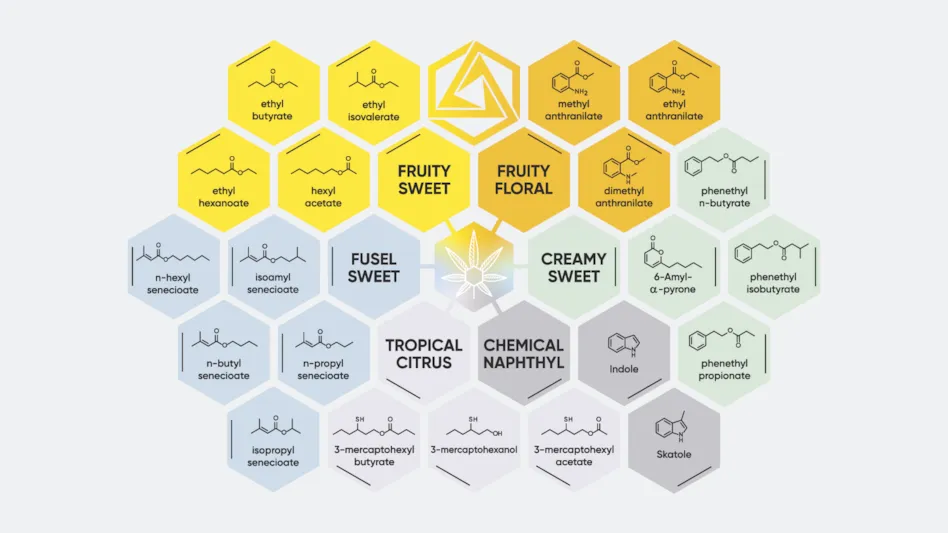
Courtesy of Abstrax Tech
Many attribute the pungent, skunky fuel aroma of a Sour Diesel or the citrus scent of a Lemon Haze to terpenes, long considered to be the primary driver of the powerful fragrances of cannabis.
But new research is reshaping this long-standing belief, which could have implications for everything from breeding to product development to labeling.
According to a paper published in October in ACS Omega, a peer-reviewed journal of the American Chemical Society, researchers have uncovered a class of compounds previously unknown in cannabis. Iain Oswald, Ph.D., one of the lead researchers of the study, tells Cannabis Business Times that the team used both sensory analysis – i.e., asking people to smell samples from modern to classic cultivars like Starburst 36, Gelato, OG Kush and GMO, and describe and rate their sweetness or savoriness on a questionnaire – and two-dimensional gas chromatography to analyze ice hash rosin samples. Researchers used ice hash rosin specifically to more easily detect cannabis compounds that are present but in lower concentrations, Oswald says.
“We had a really wide diversity of aromas going on here, which when we looked at the chemistry, after analyzing these on our instrumentation, what immediately became obvious is that varieties with completely different smells had very similar terpene profiles,” Oswald says, adding that, likewise, there were other varieties with very different terpene profiles but similar fragrances. “If terpenes truly are the differentiators in the aroma of cannabis, there should have been much greater differences in the terpene profiles, but we did not see that at all.
“The most highly rated sweet sample, which was Grape Pie x Do-Si-Do, and the least sweet, most savory, which was GMO, those two smelt completely different yet their terpene profiles were very similar. …There’s obviously something else going on.”
Using the improved resolution of the two-dimensional gas chromatography system, the researchers were able to discover two compounds they believe are responsible for the diversity of cannabis fragrances.
“All of these compounds are known in nature, but many have not been reported in cannabis. Some of them have, but the context of how they may contribute to the aroma of cannabis has not been known,” says Oswald, who is director of research and development at California-based Abstrax Tech, which conducted the study, with assistance from California State Polytechnic University—Pomona, Markes International and 710 Labs. “The compounds we homed in on in the paper have not been reported previously.”
Oswald details to CBT the most interesting and potentially impactful findings of the study.
“Our data really shows that terpenes aren't the whole story and really they're not much of the story in some cases,” he says.
Skatole Fuels Savory Aromas
Although Oswald says the compound indole is ubiquitous in nature, found in the hormone melatonin and amino acid tryptophan, it was previously undiscovered in cannabis. And another interesting aspect of indole not noted in the paper, Oswald says, is that indole’s core ring structure is found in many psychedelic drugs, such as psilocybin.
“Cannabis for some reason is producing this compound, and it contributes to the funkiness some of these cultivars have,” Oswald says.
Specifically skatole, an organic compound that is a derivative of indole, was discovered in some of the most savory varieties and those with intense aromas people described as chemical and beyond a gas or fuel fragrance, he says. Skatole also occurs naturally in mammal and bird feces. While it contributes to the chemical characteristics in some varieties, it seemed to intensify other aromas in other varieties.
“When you throw skatole in there, it enhances that gassiness to be even more aggressive. It tracked consistently with varieties described with that specific term,” Oswald says, noting examples like 710 Chem and GMO. “GMO is another beast in and of itself, and it’s because of the presence of this compound. For whatever reason, some varieties are producing this compound. We don’t know why, but they do.”
Tropical Volatile Sulfur Compounds: Papaya, Citrus, Guava
Researchers also found that varieties described as sweet and tropical, with notes of papaya, guava, mimosa and tropical citrus, all had tropical volatile sulfur compounds (VSCs), which are also found in hops and tropical fruits. Even though these tend to be in very low concentrations in the plant or rosin, they have a powerful aromatic potency, Oswald says.
“These are some of the most desired compounds in beer products in the right concentrations because they kind of bring those tropical nuances to an IPA,” Oswald says of the hoppy India pale ale beer style. “What we found in those compounds tracked very, very well with the cannabis varieties that were ranked kind of really on the sweet, tropical sort of side of that spectrum.”
Many believe that limonene is a central driver of these tropical aromas, but Oswald says this research suggests this is not the case.
“Limonene is the highest concentration compound in Grape Pie x Do-Si-Do as well as in GMO. But GMO doesn’t smell citrusy at all, so there’s something else going on,” he says. “And it's funny because, you know, further proof that limonene really isn't the driving force in that really intense citrus [smell] is the fact that some of those varieties, their highest concentration terpene was caryophyllene, which is spicy and clove-like.”
Flavorants
One of the primary findings of the research was that terpenes “don’t track well necessarily with specific aromas that people want,” Oswald says. Another takeaway is that there are different classes of compounds that do seem to be driving fragrance. So, Oswald says they refer to compounds responsible for cannabis’s unique odors that are not classified as terpenes as flavorants.
“Within that class we have esters and alcohols,” Oswald says, adding that esters are known to produce the pleasant aromas of fruit such as bananas. “And we saw a pretty good correlation between the varieties that were ranked sweeter versus less sweet … [which] is good evidence that these compounds are the true driving force behind those sweet aromas that a lot of people really want in these newer varieties.”
Oswald clarifies that these are not and should not be confused with flavonoids, which represent a class of compounds that is responsible for pigment and have been associated with positive health benefits of various fruits, vegetables, grains, nuts and legumes.
The Outlier: Terpinolene
Although terpenes didn’t seem to be responsible for chemical, tropical and sweet flavors found in cannabis, there was one outlier that researchers discovered with the terpene terpinolene.
“We had one terpinolene-rich variety in there, and terpinolene-rich varieties have consistently across multiple studies previous to us to be shown to be relatively unique in their terpene profiles themselves,” Oswald says. “And that’s what we found as well actually that that's the one dominant terpene class that we did see that terpenes were driving a lot of the aromatic differences both on the chemical side and on the sensory side.”
Oswald notes examples including Jack Herer and Trainwreck.
“People do rate them kind of to be their own sort of thing,” he says. “And from what we've seen, they do have a unique kind of fingerprint as far as their terpenes and their flavorants go.”
Industry Impact
Increasingly, cannabis producers have been moving toward more detailed labels instead of relying on THC potency or the sativa/indica dichotomy, as the role terpenes play in the effects of cannabis become more well-understood. Including more detailed flavor and aroma profiles could be beneficial for consumers looking for specific experiences, Oswald says.
“The terpenes that people put on COAs or labels, they kind of give you the overall characteristic aroma of cannabis, but these really low-concentration compounds are often times really pungent and will just overpower those notes,” he says.
The findings could also provide more clarity for breeders.
“I've seen this multiple times where on social media, a breeder might post COAs of two phenotypes that they've bred and they're confused because, you know, these things don't smell the same. Yet these COAs showing the top 15 terpenes are almost identical,” Oswald says.
“It’s all the tiny nuance that we’re looking at that’s going to make that difference.”
Oswald says if cannabis testing labs had this kind of information, it could also provide more information for consumers about specific aromas. The tests could also be used for product validation and to check the authenticity of cultivars, bringing further legitimacy to the industry.
“Something we're doing internally is we're trying to basically port over this complex analytical methodology to a more simplified system so that testing labs can actually report at least some of this information and eventually make their way hopefully to consumers,” he says. “If that’s all they care about, aroma, we can actually give them a numerical score of how tropical is this, how gassy, how chem-like, how sweet is it. And so that's the broader implication is that we could bring new information to the consumer that we haven't been able to before.”
Latest from Cannabis Business Times
- UK’S Medical Cannabis Boom: Patients, Demand and Consumption Surge to All-Time Highs - With a Record Number of Private Clinics
- ‘Mitey’ Pest Problems in Cannabis
- CryoMass Announces Sale of First Production Model to be deployed in Canada
- Ohio Medical Cannabis Operators Could Launch Adult-Use Sales in June
- 47 Ohio Localities Enact Cannabis Moratoriums Ahead of Adult-Use Sales Launch
- Key Takeaways From USDA's 2024 Hemp Report
- Cannabis Rescheduling: Where Do We Go From Here?
- Verano Opens MÜV Haines City, Company’s 75th Florida Dispensary





